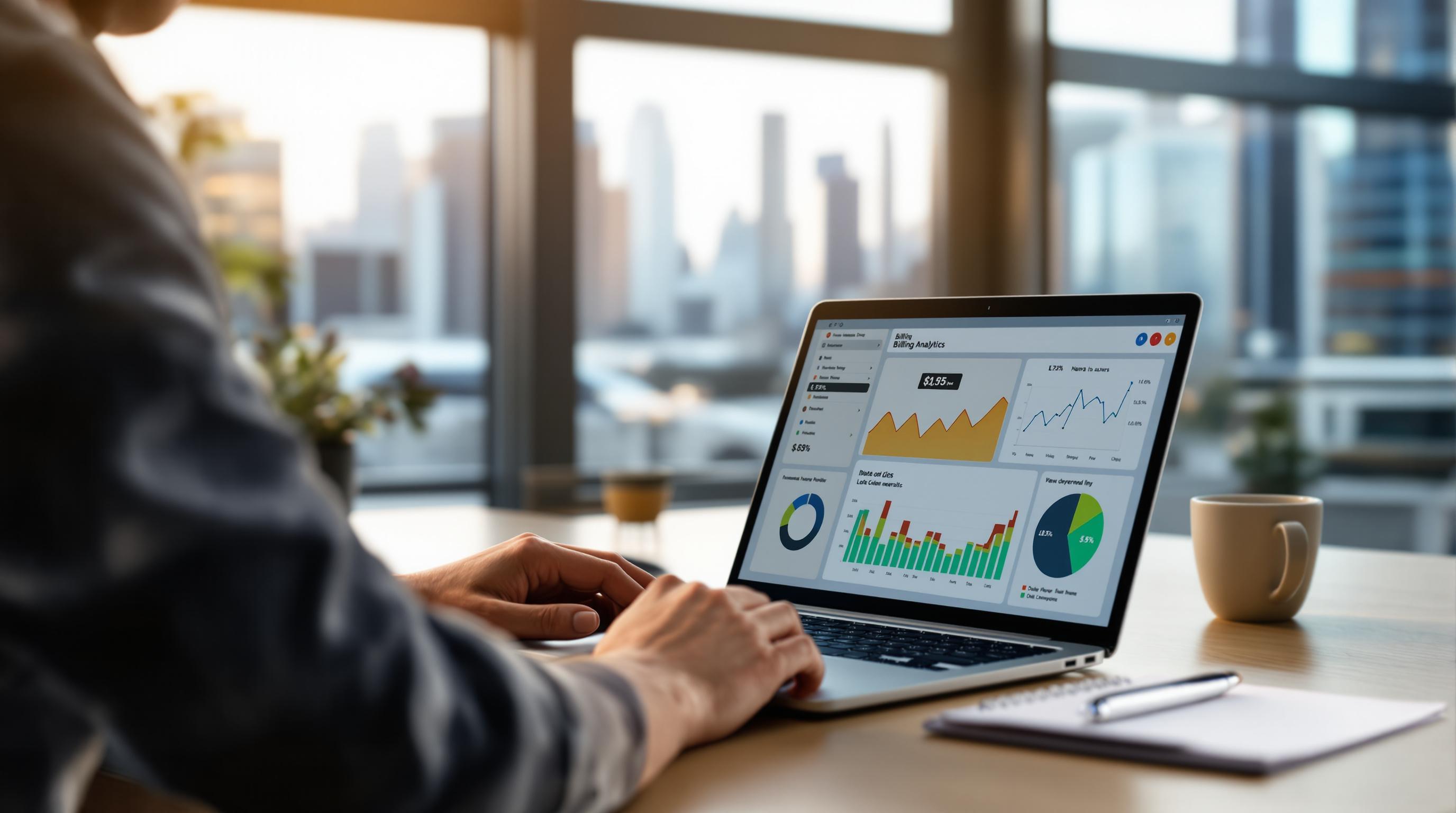Content KPIs are essential for measuring how well your content drives business goals like generating leads, boosting engagement, and increasing conversions. This guide provides actionable insights into the key metrics every B2B marketer should track, including:
- Lead Generation Metrics: MQLs, SQLs, and lead-to-customer conversion rates.
- Website Performance Metrics: Organic traffic, time on site, bounce rate, and pages per session.
- Content Engagement Metrics: Social shares, download rates, and email click-through rates.
Learn how to track these metrics using tools like Google Analytics and HubSpot, analyze performance trends, and refine your content strategy to align with business goals. Whether you're optimizing for ROI or improving audience engagement, this guide equips you with the tools and strategies to succeed.
The B2B marketing KPIs you should be tracking
Understanding B2B Content KPIs
Tracking the right metrics helps organizations measure performance and fine-tune their content strategies. This ensures that content aligns with goals like generating leads and engaging the target audience.
Types of Content KPIs
Content KPIs can be grouped into three main types: Quantitative, Qualitative, and Hybrid. Here's a closer look:
| KPI Type | Focus Area | Example Metrics |
|---|---|---|
| Quantitative | Numbers and Data | Page views, Lead count, Time on page |
| Qualitative | User Experience | Audience interaction, Brand perception, Satisfaction ratings |
| Hybrid | Combined Insights | Lead quality scores, Customer journey data |
Key Metrics to Track
A notable 73% of B2B marketers rank conversion tracking as their top KPI [3]. To build a well-rounded measurement framework, focus on these key areas:
Lead Quality Metrics:
- Marketing Qualified Leads (MQLs)
- Sales Qualified Leads (SQLs)
- Lead-to-customer conversion rates
Website Performance Metrics:
- Growth in organic traffic
- Time spent on pages
- Bounce rates
- Percentage of returning visitors
Content Engagement Metrics:
- Number of social shares
- Downloads of gated content
- Email click-through rates
Use analytics tools to monitor these metrics and evaluate how your content performs. Regularly reviewing KPIs helps identify trends and make data-driven adjustments to boost results. With the right tracking and tools, B2B marketers can uncover actionable insights to improve their strategies, which we'll delve into further in the next section.
Key B2B Content KPIs
These KPIs help you measure how well your content supports your business goals and objectives.
Website Performance KPIs
Website performance metrics highlight how effectively your content draws in and engages potential leads. Altitude Marketing notes that tracking total website traffic and organic traffic growth is key to understanding content reach and SEO impact [2].
Here are some important metrics to monitor:
| Metric | What It Measures | Why It Matters |
|---|---|---|
| Organic Traffic | Visitors from search engines | Reflects how visible your content is and how well it's optimized for SEO |
| Time on Site | How long visitors stay on your site | Indicates how engaging and relevant your content is |
| Bounce Rate | Percentage of visitors who leave after viewing one page | Helps assess if your content aligns with visitor expectations |
| Pages per Session | The number of pages a visitor views in one visit | Shows how interested and engaged your audience is |
Lead Generation KPIs
Lead generation metrics link your content's performance directly to business outcomes. Here’s what to track:
| Lead Metric | Description |
|---|---|
| Marketing Qualified Leads (MQLs) | Leads who show interest through actions like downloading gated content or subscribing to newsletters |
| Sales Qualified Leads (SQLs) | Leads approved by marketing as ready for sales follow-up |
| Customer Conversion Rate | The percentage of leads that turn into paying customers |
Content Engagement Metrics
Engagement metrics reveal how well your audience connects with your content. Data shows that 71% of B2B marketers monitor website traffic, while 73% focus on conversions to gauge content success [3].
Keep an eye on these key engagement indicators:
- Social Shares: Reflects how valuable and shareable your content is
- Download Rates: Measures the effectiveness of lead magnets like eBooks or whitepapers
- Return Visit Rate: Indicates your content’s ability to establish authority and keep visitors coming back
Tools like Google Analytics can help you track these metrics consistently. For a clearer picture of your content's success, combine multiple data points. For example, pairing high time on site with strong conversion rates often signals content that not only engages but also drives results.
With these KPIs in mind, the next step is learning how to effectively track and improve them.
Tracking and Optimizing Content KPIs
Tools for Tracking KPIs
Tracking the performance of B2B content requires dependable tools that offer insights into traffic, leads, and overall content effectiveness. Tools like Google Analytics, HubSpot, and various SEO platforms are excellent for gathering this data.
| Tool Category | Key Features | Best For |
|---|---|---|
| Analytics Platforms | Track traffic, user behavior, and conversions | Understanding audience engagement and content performance |
| Marketing Automation | Lead scoring, campaign tracking, and attribution | Connecting content to lead generation and nurturing efforts |
| SEO Tools | Keyword tracking and optimization | Boosting organic search visibility and performance |
Using these tools effectively means going beyond just collecting data - you need to turn it into meaningful insights.
Analyzing KPI Data
Analyzing KPI data is about digging deeper than just the numbers. Look for patterns and trends that reveal what’s working and where you can improve. Focus on these areas:
- Performance Trends: Track how metrics evolve over time. Are there seasonal spikes, or do certain types of content consistently perform better?
- Conversion Pathways: Understand how users interact with your content before converting. This can highlight which pieces of content are most effective in driving action.
- Content ROI: Compare the cost of creating content to the revenue or value it generates. This helps you assess whether your investment is paying off.
By tying these insights to your business goals, you can refine your content strategy to achieve measurable results.
Improving Content Strategy
Surveys show that 73% of marketers prioritize conversions, while 71% focus on website traffic [3]. To get the most out of your efforts, pay attention to these areas:
- Content Format: Use engagement data to figure out which formats - like videos, blogs, or infographics - resonate most with your audience.
- Topic Selection: Review your top-performing content to identify themes or subjects that consistently drive results.
- Distribution Channels: Zero in on the platforms that yield the highest engagement and conversions, whether it’s email, social media, or organic search.
For better results, align your content with search intent using SEO tools. Focus on what your audience values most and double down on the formats and channels that deliver the best outcomes.
sbb-itb-01010c0
Using KPIs to Improve Content Strategy
Linking KPIs to Business Goals
To sharpen your content strategy, start by connecting specific KPIs to your main business goals. This approach helps you focus on metrics that have a direct effect on your company's success.
| Business Goal | Primary KPIs | Secondary KPIs |
|---|---|---|
| Revenue Growth | Lead-to-customer conversion rate, Sales qualified leads | Time to conversion, Content attribution |
| Market Penetration | Share of voice, Website traffic growth | Geographic reach, Industry authority metrics |
| Customer Retention | Content engagement rate, Return visitor rate | Customer feedback scores, Resource usage |
Once you've aligned KPIs with your business goals, use the insights from this data to fine-tune your content strategy.
Making Adjustments Based on Data
Analyzing data and making targeted changes are key to improving your content's performance. Focus on these areas to get the best results:
Content Format Optimization
- Identify which content formats bring in the most leads and adjust your content mix to emphasize those.
- Track engagement metrics to see which types of content resonate most with your audience.
Distribution Channel Performance
| Channel | Key Metrics to Monitor |
|---|---|
| Open rates, Click-through rates | |
| Social Media | Engagement rate, Share of voice |
| Website | Time on page, Bounce rate |
Fine-tuning your distribution channels ensures your content reaches the right audience and supports the KPIs tied to your business goals.
Content Personalization
Customize content to address specific industry challenges, buyer preferences, and how your audience consumes information. By analyzing engagement data, personalized content can strengthen audience connections and boost engagement-related KPIs.
These tweaks help keep your content strategy flexible and aligned with changing business priorities.
Conclusion
Main Points
Tracking B2B content KPIs is essential for creating marketing strategies based on real data. A well-structured KPI framework helps monitor website performance, lead generation, and engagement, ensuring your content aligns with your business objectives.
Here’s how it helps:
- Measure Impact: Keep an eye on both short-term engagement and long-term business results.
- Allocate Resources Wisely: Identify top-performing content formats and distribution channels to focus your efforts effectively.
| KPI Category | Primary Focus | Business Impact |
|---|---|---|
| Website Performance | Organic traffic, Conversion rates | Drives revenue growth |
| Lead Generation | MQLs, SQLs | Expands the sales pipeline |
| Content Engagement | Time on page, Social shares | Builds brand authority |
Next Steps for B2B Leaders
To implement a successful KPI framework, consider these practical steps:
- Use tools like Google Analytics to track essential metrics such as website performance and engagement.
- Ensure KPIs are directly tied to your business goals, like increasing revenue or expanding market reach.
- Leverage analytics platforms, including The B2B Ecosystem, for deeper insights.
- Review your KPI data regularly - monthly is a good benchmark - to identify trends and refine your strategy.
Additional Resources
The B2B Ecosystem
The B2B Ecosystem offers AI-driven tools like QuantAIfy to analyze content performance and predict trends. They also provide consulting services aimed at improving KPI tracking and refining strategies. Their communities and publications create a space for B2B leaders to exchange insights and address common challenges in content measurement. By combining advanced tools with expert advice, The B2B Ecosystem helps transform raw data into actionable strategies, making it a trusted resource for B2B professionals.
In addition to these specialized solutions, there are other tools that can help you track KPIs effectively.
Recommended Tools and Guides
Some of the top tools for KPI tracking include:
- Google Analytics: Ideal for monitoring website performance and understanding user behavior.
- HubSpot: Combines marketing automation with analytics to streamline lead tracking and campaign insights.
- SEMrush: Focuses on SEO and competitor analysis, helping you stay ahead in search rankings.
For further learning and industry expertise, these resources are worth exploring:
- Content Marketing Institute and MarketingProfs: Offer practical guides, benchmarks, and case studies for improving KPI tracking and content performance.
- HubSpot Academy: Provides in-depth courses and certifications on content marketing analytics, making it easier to navigate the technical side of KPI measurement.
Using these tools and resources can help you create a solid, data-driven approach to content strategy, ensuring your efforts align with your business objectives.
FAQs
What are the social media benchmarks for B2B?
Social media metrics give you a closer look at how your audience interacts with your content. Here's a snapshot of important performance targets based on August 2024 data:
| Metric | Target Benchmark | What It Means |
|---|---|---|
| Engagement Rate | Over 3% | Shows strong audience interaction, far above the industry median (less than 1%). |
| Post Reach | 20% of total audience | Tracks how much of your audience is seeing your content. |
| Weekly Social Shares | 5+ per week | Reflects your content's ability to spread and gain audience support. |
| Comments | 3+ relevant, positive comments per post | Indicates your content is sparking meaningful conversations. |
To hit these targets, focus on a few key areas:
Content Quality and Format
- Create videos, infographics, and other engaging formats that tackle your audience's challenges.
- Publish content that encourages real conversations and feedback.
Channel Selection
- Use LinkedIn to connect with professional B2B audiences.
- Test different content styles (A/B testing) to see what works best.
- Post at times when your audience is most active.
"High-quality content that addresses specific audience needs and provides real value is crucial for achieving high engagement rates" [5]
For better results, keep an eye on these metrics:
- Website traffic coming from social platforms.
- Conversion rates from social media leads.
- How social media impacts your sales funnel. [1][4]


